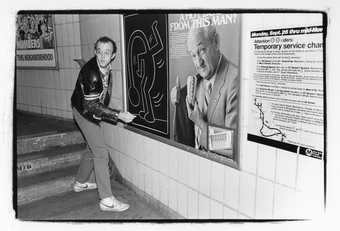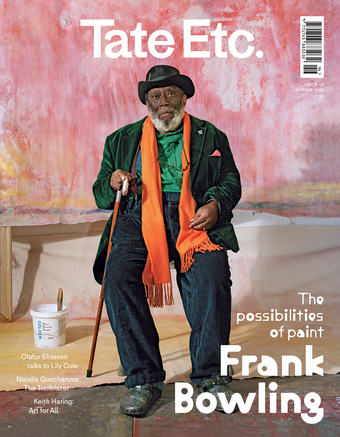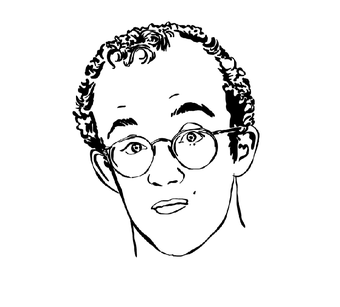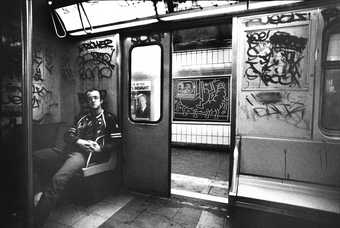
Keith Haring drawing on a subway platform, New York City, c.1982
Photo: Laura Levine/Corbis/Getty Images
I first met Keith (1958–1990) when he interviewed me for the position of Studio Manager in May 1984. As a native New Yorker, I – like so many others – first saw Haring’s work in the New York City subway stations. His philosophy was that art was for everyone, not just those who were museum and gallery-goers. Hence, the subway drawings, the Pop Shop (a boutique selling Haring merchandise) and his public murals, many of which still exist. The idea of democratising art in this way was in part inspired by his having seen the film about Christo’s Running Fence 1972–6 (a 24.5-mile fence veiled with white nylon fabric, extending across the hills of Sonoma and Marin counties in northern California). But just as influential was the fact that the audience for his first significant public works was composed of the millions of ‘ordinary’ people who rode the subway every day. He loved the performative aspect of creating work for, and in front of, the public – particularly children. However, he was also determined to be taken seriously by the traditional art world, to show his work in museums and galleries. This was a goal he would eventually achieve, but he never abandoned the public that had been his first audience.
The whole beauty of the drawings was that they were so simple. They told a story that you could see from a moving train and you could get it.
– Keith Haring, interviewed by John Gruen in 1989, Keith Haring, Rizzoli, New York, 2008
Haring’s murals were rarely commissioned, but even when they were, he would pay for or donate almost all of the materials and his time. Haring did show his work in museums and galleries, all the while continuing to create public works, both outdoors and in. When he travelled around the world for exhibitions of his work, he always wanted to ‘leave something behind’ for the people. And so, often without permission from the authorities, Haring would seek out locations in impoverished neighbourhoods and inquire about the possibility of doing a mural. More often than not, the answer would be ‘yes’ and, with the help of locals he had met, he would paint one. It was usually Keith himself who took the initiative, seeking out the locations, materials, scaffolding and assistants. Most of his indoor murals were in hospitals or schools, and those required permission by those in charge. Some of his outdoor murals were done illegally, however, resulting in fines. In a couple of such instances, he subsequently pursued city permission and was granted it retrospectively.
Art lives through the imaginations of the people who are seeing it. Without that contact, there is no art.
– Keith Haring, Flash Art, March 1984
I believe his legacy is that art should be for everyone, that art can heal, that it can bring awareness to social causes, and that artists are activists and have a responsibility to expose injustices of all kinds. Haring was among the very first to embrace the concept of disseminating his imagery in so many different ways, which was extremely controversial at the time, and occasionally still is, even today. Of equal importance is his invention of a truly unique visual vocabulary, one that caught – and still catches – the attention and imagination of people of all ages, from all walks of life. And, as if that weren’t enough, he was extremely thoughtful about his own legacy, establishing the Keith Haring Foundation in 1989, to carry out his philanthropic goals. Pretty remarkable for an artist whose career spanned barely 12 years, and who died at 31.
Keith Haring, Tate Liverpool, 14 June – 10 November, curated by Darren Pih, Curator, Exhibitions & Displays, and Tamar Hemmes, Assistant Curator, Tate Liverpool. The exhibition is realised in collaboration with the Keith Haring Foundation, and in partnership with Centre for Fine Arts (BOZAR), Brussels and Museum Folkwang, Essen. It will tour to BOZAR, 5 December 2019 – 19 April 2020, and Museum Folkwang, 22 May – 6 September 2020.
Julia Gruen is Executive Director of the Keith Haring Foundation.





